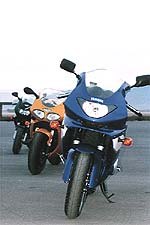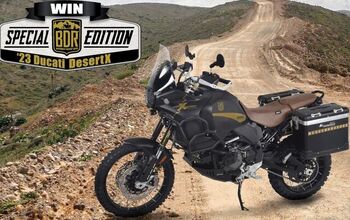
Get the Flash Player to see this player.
We Are Worthy And We'll Prove It: See The Motorcycle Online StaffLOS ANGELES, January 18, 2000 -- Newer is not always better. In many ways, a tried-and-true two- or three-year-old design is often a better option than the latest cutting-edge machine. There are plenty of "older" designs still offered by manufacturers that cost less than the leading-edge machine of the moment and, with what the aftermarket offers, you can actually build a motorcycle with comparable performance and handling characteristics. So we've rounded up three of our favorites bikes that have, somehow, got lost in the hype and ensuing shuffle of latest, greatest track-scratchers. It just happened that we ended up with a twin, a triple and a four, so we've got a little dash of every flavor represented here.
Yamaha YZF-600R
The YZF's trump cards are its excellent ergos, wind protection and super smooth motor that doesn't intimidate novices like the peakier R6 can. The motor has little power below 4,000 rpm but above 6,500 rpm it spools power jet-turbine smooth up to its redline, although power begins to plateau around 10,000 rpm. The handling is predictable with no bad habits. The suspension has a decent range of adjustability and, though it's main mission is the street, it can be stiffened up rather easily for a day at the track. The only real gripe with this bike is that it's a bit portly and the somewhat grabby clutch has a very narrow range of engagement.
Because aftermarket suppliers are focusing on the track-oriented YZF-R6, upgradability is more limited for the YZF-600R but, because of the bike's racing history, if you look, there are plenty of goodies to be found. While we felt that the stock suspension and brakes were fine, we installed a Fox rear shock on a previous test model and it helped to add even more control to an already solid package. The YZF-600 was never a strong competitor at the track, but pipe and jet-kit options are availiable to put some spice in the YZF's life. Yoshimura makes a carbon-fiber slip-on that saves a reported 12 pounds. Also, by installing the pipe and shimming the needles, the 600R picks up about five horsepower. Because the YZF comes with only a 160 rear tire, choices are limited. Fear not, however, since our new favorite street tire -- the Michelin Pilot Sport -- is available in that size.
Because of technology, should Calvin crash, he has a lesser chance of becoming a vegetable and hence, a burden to society. We should all care, really, about the social benefits and costs of technology.
As a street bike, this stock Yamaha is one of the best 600s on the market. It has a smooth motor, excellent wind protection and suspension flexible enough to handle 600-plus mile days in comfort. It loves twisty back roads where the stable chassis can be put to good use, and it's not averse to a day at the race track, though there are better choices if more than a handful of track days are in your future. The few recommended mods make a noticeable difference, but it's still not the tool with which to go about chasing track records. But, for a novice on the track, this bike proved to be one of the best and on the street nobody complained when they straddled this bike. Also, if you're an advanced rider in the market for a solid 600, one that is reasonably priced and will do everything and do it well, then take a good, long look at the Yamaha YZF-600R.
Honda VTR1000 SuperhawkThe VTR was the first attempt by Honda to introduce a sporty, road-going V-twin to the general public. The Superhawk was designed from the ground up to be a street bike first and foremost. But, unfortunately for Honda, Suzuki released its TL1000S at about the same time and, due to higher power numbers and more "character," the TL became the media darling and the motorcycle of choice for back road and track-scratchers everywhere who wanted a go-fast V-twin experience without the Ducati price tag.
Notice the Nevada dust on the VTR's wheels. While at the STAR School, Mark Hammond had this wacky idea that the VTR would make a killer enduro, so he just rode off the track and into the desert. Just like that. He's a very strange man but he's also bald and mean-looking and no one here has the guts to tell him we find him odd.
The first thing you notice when riding the Superhawk is that the bike feels very narrow between your legs. The tank is sculpted with large indents and the minimalist windscreen that makes for such windy high-speed cruising contributes to an overall feeling of lightness. The VTR has good power across the rev-range that, when coupled with almost instant throttle response, makes for a motor that has power on demand. The suspension is decent for the street, offering up a cushy, well-damped ride at the moderate speeds common in everyday commuting and back-road strafing. The biggest drawback about the VTR has been well-documented: It has horrendous range. Basically expect to visit a filling station every 100 miles or so. Unfortunately, this puts a serious crimp on longer-distance sport-touring on what could be a pre-eminent sport-touring machine.
We expected this bike to be the Prince of Pahrump but, in the end, it wasn't to be. The VTR needs suspension work and more top-end power to be an capable track bike. The front end is underdamped, the brakes aren't superb and the motor needs more hit to give it some personality. Still, the things that hold the bike back on the track are what make it one of the best street bikes available. The suspension can soak up super-slab nastiness with the best of them, the motor has power everywhere and the ergos are comfortable. If you crave track days or the need for a heaping helping of personality, we heartily recommend Erion Racing's exhaust system (mufflers and jet kit), which retails for $599.00. It adds seven horsepower across the board and sheds eight pounds in the process. Also, consider a suspension re-valve from Race Tech, who will install their excellent Gold Valves in the forks and re-valve the rear shock for a very reasonable $185.00 ($100 forks, $85 shock).
The Superhawk is perplexing in that with a few more race-inspired factory tweaks to ergos, suspension and the motor, the VTR would be a great track bike and nobody would have noticed the TL1000S at all. Was the VTR was a stop-gap until the RC51 came along? With more range and wind protection, this motorcycle could even give Honda's own VFR800 a run for its sport-touring money, and do so with a V-twin flair. Still, unless you ride primarily on track days or enjoy serious, long-distance sport-touring, the VTR is one of the most enjoyable street machines available. It has V-twin personality mated with the usual Honda build-quality, creating a machine with a smiles/mile ratio that far outweighs its few shortcomings.

Motorcycle.com presents an unrivaled combination of bike reviews and news written by industry experts
More by Motorcycle.com Staff







































Comments
Join the conversation